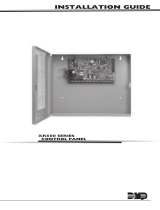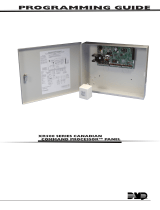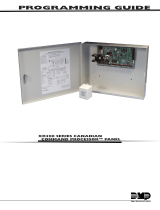Page is loading ...

3M™ Dual Comm RF Monitoring System
RF (E4)
Product Overview

1
1 1
1 Introduction to
Introduction to Introduction to
Introduction to the
the the
the 3M™
3M™ 3M™
3M™ Dual Comm
Dual CommDual Comm
Dual Comm
RF Monitoring System
RF Monitoring SystemRF Monitoring System
RF Monitoring System
3M Electronic Monitoring offers the new Dual
Comm RF Monitoring System – a multi-client-
monitoring unit that is capable of monitoring
up to 50 client transmitters within the
monitored perimeter. The RF (E4) Receiver
unit also has the capability to manage the
various program schemes, event
configurations, and schedules assigned to
each client.
RF (E4) Receivers are dual communication
units – able to communicate with the central
monitoring computer via landline and/or via
cellular communication. Users can specify
either communication type, or can use both
methods together for redundancy.
The RF (E4) Receiver unit installation is easy, simple, and quick; all one needs is to plug in
the power adapter (and the phone cord when landline communication is being used). The
LCD screen and buttons enable a simple, intuitive installation process, and afterwards, they
enable easy status monitoring.
The unit can start tracking the offender as soon as it is installed (utilizing the default
parameters).
The installation process is completed after the monitoring center’s Data Communication
Computer (DCC) downloads the unit’s parameters (such as curfew schedule, transmitter ID,
call-back phone numbers, settings, etc.) into the RF (E4) Receiver unit's memory, thereby
setting the unit to active monitoring mode. The RF (E4) Receiver internally connects the
backup battery and starts tracking the offender.
Main Characteristics
Main CharacteristicsMain Characteristics
Main Characteristics
Multiple offenders monitoring
Dual communication modules (Landline and Cellular)
3.5” color LCD with 5 buttons
Remote software update capabilities
Flexible scheduling and information management
Four-tamper transmitter support
Two-way communication with emergency and monitoring centers (cellular version)
Highly advanced tilt sensors and tamper alarms
Automatic configurable monitoring range

Encrypted communication protocol in accordance with NSA suite B
Short messaging and GPRS communication capabilities
Enhanced, fast installation
Event capturing even when transmitter is out of receiver range
Physical Characteristics
Physical CharacteristicsPhysical Characteristics
Physical Characteristics
Dimensions
H=90mm
L=285mm
W=185mm
H=3.5433 in
L=11.2205 in
W = 7.2835 in
Weight
1210 g* 2.667 lbs*
* excluding external power adapter and cables
Power Supply
The 3M™ Dual Comm RF Monitoring Receiver is powered by an external
power adapter, which converts the mains 110VAC into a 12VDC 1A
supply current.
LCD
3.5 Color
Resolution: 320 x 240
White LED Backlight
Main Features
Main FeaturesMain Features
Main Features
Monitoring multiple transmitters
The 3M™ Dual Comm RF Monitoring Receiver is capable of receiving transmissions from
any 3M Electronic Monitoring transmitter. It's ability to communicate with all types of 3M
transmitter enables maximum equipment handling flexibility. The 3M™ Dual Comm RF
Monitoring receiver can store up to 50 offender curfew schedules, and concurrently
monitor up to 50 offenders. The basic unit is supplied with a software license for
monitoring 1 offender; additional monitored offenders are supported depending on the
license purchased.
3.5” color LCD with 5 buttons
The 3M™ Dual Comm RF Monitoring Receiver is
equipped with a 3.5” color LCD and 5 buttons. The
LCD screen and the buttons are used to display
and interact with the Receiver unit’s User
Interface, which includes:
Displaying date and time (synchronized to
each offender's schedule)
Displaying status information (such as cellular
reception indications)

Displaying error reports
Displaying various configuration options as part of the
officers’ configuration screens (which are password
protected, and can optionally be totally disabled remotely
to ensure absolute security)
Four-tamper transmitter support
The 3M Electronic Monitoring ankle and wrist transmitters
(TX-860 / TXS-860) are equipped with four tamper-detection
mechanisms. The transmitter detects and reports when:
The strap is opened or cut (including when done inside
conductive solutions, e.g. salty water)
The transmitter is removed from the offenders’ body,
even without opening or cutting the strap (detected using
the proximity alarm feature, also referred to as "body
alarm").
The transmitter is not moving; this may indicate that the transmitter has either been
removed, or the subject is unconscious.
The case is tampered with; any attempt to open or break the case of the transmitter
is detected.
Installation and activation
The 3M™ Dual Comm RF Monitoring Receiver installation process has been enhanced
and improved:
The standard installation process is quick and automatic, and can be performed at an
offender’s home independent of the central monitoring center personnel.
The receiver unit’s LCD screen displays status information which helps guide the
officer through every step of the installation process. If errors occur, they are easy to
identify and resolve.
The installation and activation process takes only about 5 minutes, when range
testing is not performed. When range testing is performed, the installation typically
takes an additional 3-5 minutes, depending on the thoroughness of the range testing
process.
Advanced configuration options are available using the officer configuration screens.
The unit supports a self-installation option by which an offender can independently
install the receiver unit at his or her home, and the system will automatically verify
whether the offender installed the unit at the proper location.
Encryption
The 3M™ Dual Comm RF Monitoring Receiver unit communication is encrypted using
high secured protocols. The communication between the receiver and the transmitter, as
well as between the receiver and the Data Communication Computer (DCC), are fully
encrypted for full security using the latest encryption algorithms. This ensure that
offenders cannot duplicate transmitter signals in order to deceive the system. The
encryption protects the communication channels against
Eavesdropping
Unauthorized modifications

In addition, the encryption protocols strengthen the reliability and integrity of
communicated messages.
The encryption protocol is in accordance with NSA Suite B, namely, AES for symmetrical
key encryption and authentication, GCM for block chaining, public key-based certificates,
use of the Elliptic Curve Digital Signal Algorithm (ECDSA) for certificate verification, and
key establishment.
Data storage capabilities
The 3M™ Dual Comm RF Monitoring Receiver unit's Random Access Memory (RAM) can
store up to 18000 events. The events are deleted from the memory after they have been
successfully transferred to the central Data Communication Computer (DCC).
Communication may be triggered by the occurrence of an alert event, and otherwise
occurs during the Receiver's scheduled call-ins or in response to upload requests from
the monitoring center.
The 3M™ Dual Comm RF Monitoring Receiver features independent monitoring
capability. The unit stores offender schedules, enabling it to differentiate between
permitted and forbidden offender absences as defined by that schedule even at times
when communication with the central monitoring stations is not possible. The unit stores
in its memory all non-violation schedule-related events until they can be uploaded.
GPRS communication
The 3M™ Dual Comm RF Monitoring Receiver unit utilizes the most advanced
communication including GSM networks that enable GPRS (General Packet Radio
Service) communication. GPRS is an "always-online" service, which provides high-speed
data services for cellular networks. With GPRS communication you pay only for the
volume of data sent and received (usually on a monthly basis).3G support is available
Communication prioritization policies
The 3M™ Dual Comm RF Monitoring Receiver supports both landline communication and
cellular communication, including both the GPRS and CSD protocols. Users can define
prioritization for each of these communication methods for each unit, enabling or
disabling these options as desired. Furthermore, users can define prioritization for these
options. For example, the primary method can be landline communication. When the
unit detects that the landline is unavailable, cellular GPRS communication can be used. If
GPRS is unavailable, CSD can be used to transmit event data to the central monitoring
station. This versatility ensures maximum reliability.
Tamper recurrence mechanism
The 3M™ Dual Comm RF Monitoring Receiver detects and reports any attempt to tamper
with the unit. The Receiver can detect if the unit’s case was opened, if the unit was
moved or tilted, if the power or phone line have been removed, if the SIM card case is
opened, or if someone is accessing the officers’ configuration screens.
The respective messages are:
Case open / Case closed
Tilt / Receiver not in tilt
Power failure/restored
Phone line failure/restored
SIM card open
Officer menu accessed

Dynamic range setting
The 3M™ Dual Comm RF Monitoring Receiver unit is equipped with four default range
options, which can be configured by the officer and tested at the offender’s residence or
remotely from the monitoring center.
Short – 5-14 meters (in an open field environment)
Medium – 12-27 meters (in an open field environment)
Long – 23-45 meters (in an open field environment)
Maximum – Up to 150 meters (in an open field environment)
Users can initiate a range test directly from the Receiver unit’s built-in interface,
enabling the Receiver unit to automatically determine the optimum range settings for
the offender’s home conditions without needing to communicate with the monitoring
center. Alternatively, the range setting can be manually defined remotely from the
central monitoring station.
Two way RF communication
The 3M™ Dual Comm RF Monitoring Receiver is capable of two way RF communication
with the transmitter. This means that the Home receiver unit can transmit data to the
transmitter and not just receive data from the transmitter (as in the previous
generations of the home unit receiver).
This option enables:
Automatic software upgrades to the transmitter
Storing and loading events during absence periods
Programmable option to define how often transmissions are made
Event storage outside the curfew area
The 3M™ Dual Comm RF Monitoring receiver and transmitter are capable of recording
tamper events even when the transmitter is out of the receiver’s range (such as when
the offender is away from home during a permitted absence).
The transmitter will detect and store any tamper event. After the offender returns to the
curfew area the events are automatically sent to the receiver and uploaded to the
central monitoring station. Each event’s timestamp reflects the actual point in time that
the tampering event took place, even after a delay.
Backup battery
The 3M™ Dual Comm RF Monitoring Receiver is equipped with an internal backup battery
to ensure uninterrupted operation during power failures. The backup battery provides
approximately 48/24 hours of continuous power for monitoring, including scheduled
calls to the central monitoring server.
When a power failure is detected, a notification message is logged and the unit continues
to work using backup battery power. As long as backup power is being used, the unit
periodically (as defined in a parameter) uploads a reminder message, “Battery is still
disconnected”. The unit is capable of reporting the battery status via events (such as,
"battery medium charging level" or "low level charging").
If AC power is not restored for after more than 48 hours and the backup battery runs
out, the unit's data contents are still preserved by a secondary Lithium backup battery.
When the 3M™ Dual Comm RF Monitoring Receiver unit detects a power failure, it beeps
to notify the offender or another people in the offender's home that power has been lost.

In cases where the power loss was caused simply by accidentally unplugging the unit,
this notification prompts to reconnect it.
Upon completion of an offender’s program and the Receiver’s service is ended, the
backup battery is automatically disconnected. This preserves the backup power so it will
be available immediately when the unit is activated at the next offender’s premises.
Basic Operation
The 3M™ Dual Comm RF Monitoring Receiver has three sockets for external cable
connection:
Power socket (12v)
Phone line socket
Connected-phone socket
The Receiver is simple to install and has a basic, straightforward man-machine-interface
that consists of three LEDs and an internal buzzer.
The three LEDs indicate the following:
External Power Connected
Transmissions reception (operates only during installation mode and during range
testing)
Phone line connected
The following figure demonstrates the 3M™ Dual Comm RF Monitoring Receiver basic
connection requirements.

Safety hazard prevention
The scope of the 3M™ Dual Comm RF Monitoring Receiver safety features includes:
Fire Resistance – Flame resistant material is incorporated into Receiver case
material. This provides a V0-94 flammability rating, which reduces the Receiver's risk
of fire hazard following an electrical short-circuit or a lightning strike. All plastic
materials within the Receiver (such as printed circuit boards, electrical wire coating,
etc.) are UL approved with a V0-94 flammability rating.
High Voltage Isolation and Insulation – Protection is included against high-voltage
penetration via the Receiver's power supply, or via the phone line following a
lightning strike.
The 3M™ Dual Comm RF Monitoring Receiver's 110VAC or 220VAC to 12VDC power
adapter features double insulation; a single failure in the adapter will not transfer the
110 VAC or 220VAC into the unit. Furthermore, a 2A fuse is provided to compensate for
unexpected high-power consumption, which may be an indication of a short circuit.
The phone-related circuits feature a galvanic separation from the low-voltage circuits by
means of opto-couplers and transformers at the interfaces between the two circuit types.
In addition, the non-conductive plastic Receiver case provides insulation between the
user and the electronic components within the unit.
Durability
The 3M™ Dual Comm RF Monitoring Receiver unit is made of a fire-resistant, rugged
ABS case. The V0-94 flammability rating of the unit case provides the highest degree of

fire resistance for a polymeric material. The unit case has been tested for free fall and
vibration, as well as a range of climate environment standards.
FCC Notices
The Product complies with Part 15 of the FCC Rules. Operation is subject to the following
conditions:
1) This device may not cause harmful interference
2) This device must accept any interference received, including interference that may cause
undesired operation.
3) Changes or modifications not expressly approved by Elmo Tech Ltd could void the user’s
authority to operate the equipment.
ATIS/ACTA Customer Information
This equipment, Smart Base Unit, model: SBU x000yyy (1), complies with Part 68 of the
FCC Rules and the requirements adopted by the ACTA. On the bottom panel of this
equipment is a label, that contains among other information, a product identifier in the
format US: LSQAL01BSBx000yyy. If requested, this number must be provided to the
Telephone Company.
This equipment is designed for connection to the telephone network using an RJ-11
connector, which is Part 68 compliant. See Installation Instructions for details.
The REN is used to determine the number of devices that may be connected to a telephone
line. Excessive RENs on a telephone line may result in the devices not ringing in response to
an incoming call. In most but not all areas, the sum of RENs should not exceed five (5.0). To
be certain of the number of devices that may be connected to a line, as determined by the
total RENs, contact the local telephone company. The REN for Smart Base Unit, model: SBU
x000yyy, is 0.1B.
If the Smart Base Unit, model: SBU x000yyy, causes harm to the telephone network, the
Telephone Company will notify you in advance that temporary discontinuance of service may
be required. If advance notice is not practical, you will be notified as soon as possible. Also,
you will be advised of your right to file a compliant with the FCC if it is necessary.

The Telephone Company may make changes in its facilities, equipment, operations or
procedures that could affect the operation of the equipment. If this happens the telephone
company will provide advance notice in order for you to make necessary modifications to
maintain uninterrupted service.
If trouble is experienced with the Smart Base Unit, model: SBU x000yyy, for repair or
warranty information please contact: Pro Tech Monitoring, lnc., 1838 Gunn Highway,
Odessa, FL 33556, Phone 888.67.SMART, FAX 813.749.5474. If the equipment is causing
harm to the telephone network, the telephone company may request to disconnect the
equipment until the problem is resolved.
The Smart Base Unit, model: SBU x000yyy, installation is described in Section 2 of the
Smart Base Unit, model: SBU x000yyy, Maintenance Manual. Connection to Telephone
Company and providing coin service is prohibited. Connection to party lines service is
subject to state tariffs.
(1) x = 1 digit number that represents the SBU model's mechanical design.
yyy = 3 digit number that represents the SBU model's RF related characteristics.
Caution:
Risk of explosion if battery is replaced by an incorrect type.
Dispose of used battery according to the instructions
E4-RF stand-alone is intended for maximum permitted operating ambient of 55degC.
Caution! Risk of explosion if batter5y is replaced by an incorrect type. Replace only with the same
type and manufacturer. Dispose of used batteries in accordance with the manufacturer
instructions.”
Unit shall be used only with certified Limited Power Source (LPS) AC/DC adapter having floating
output rated 12VDC, min. 2A, suitably rated for intended operating temperatures.
/



